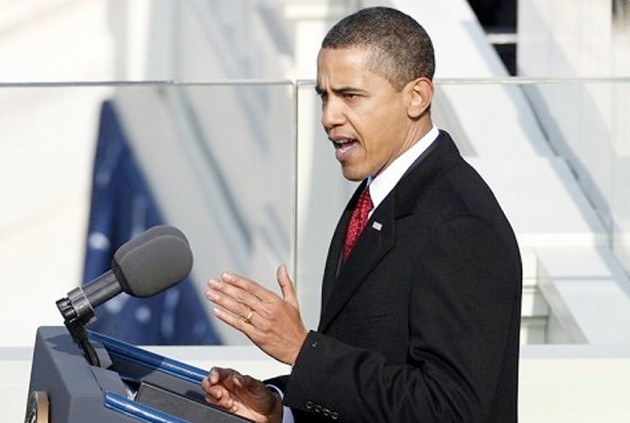Students find ways to witness history

Tiffany Coakley couldn’t head to the nation’s capital to see Barack Obama take his oath of office.
But that didn’t stop the communications major from being photographed with America’s 44th president Tuesday.
“I may not have been in D.C., but I can say that I took a picture with him and that I witnessed history being made,” she said, referring to the life-size cutout of Obama in the Marshall Student Center Ballroom.
Coakley was one of the estimated 900-plus students, faculty and staff members who filled the room at noon to watch Obama’s inauguration.
Every chair in the ballroom was filled, attendees said, and people lined the walls and craned their necks to see the event on one of the room’s two projector screens. Across the hall, others gathered in the Oval Theater, but the inaugural experience wasn’t confined to the second floor of the center.
Just below these parties, students clotted the walkways to Beef ‘O’ Brady’s and, halfway across campus, they clustered in the lobby of the Communication and Information Science (CIS) Building, as well as the Grace Allen room of the Library.
“It was all over campus — it was what everyone was doing at that certain time,” said English major Sommer Geck.
Provost Ralph Wilcox sent an e-mail Tuesday to faculty members, encouraging them to tune in to the event. Wilcox left it up to instructors’ discretion whether to cancel class for the occasion.
Many students said their afternoon classes were noticeably thinner and some who decided not to skip said resisting the temptation to sneak a glimpse of the inaugural coverage proved difficult.
Environmental science and policy major Kris Caldwell and biomedical science major Sarah Monson said they logged on to cnn.com during their biology class to watch streaming video of Obama and Vice President Joe Biden’s swearing-in ceremony.
Apparently, they weren’t the only ones.
A notice on the CNN Web site stated that users would have to wait since the program couldn’t stream video to all of the people on the site at once. After about 10 minutes waiting for the video to load, Caldwell and Monson decided to pack up their laptop and wait for the end of class.
“We ran from class to the Marshall Center,” Monson said. “We were standing in the middle of Beef ‘O’ Brady’s, just watching. Everybody got very quiet and very focused when Obama gave his speech. It felt very historic.”
Just before Obama delivered his address, CNN reported it had 1.3 million people watching live online, with 21.3 million live video streams worldwide since 6 a.m. That’s more than four times CNN’s total daily streaming record of 5.3 million, set on election day.
CNN also created a special Facebook tool for the event, which received an average of more than 4,000 comments a minute during its peak, the U.K.’s Times Online reported.
During Obama’s 20-minute speech, he addressed America’s need to usher in a new era of responsibility, saying it was the risk-takers and doers of the past who made the nation prosperous. The United States’ capacity for greatness — its ability to invent, care and achieve — hasn’t waned in the time since, he said, underscoring his campaign motto of creating change.
“What I really admired about this speech is that he said he will do these things — that they will happen, not that they might happen,” Geck said, referring to Obama’s pledge to forge friendships in the Middle East, extend a hand to nations in need and defeat terrorism.
Though the crowds in the buildings on campus weren’t nearly as massive as the million or so who gathered on the west front of the Capitol, many said they didn’t mind watching in somewhat cramped quarters.
“It seemed like the kind of event where people would rather experience it shoulder to shoulder, all crowded together, than watching it by yourself,” said Dewey Rundus, associate director of Undergraduate Research.
He watched the inauguration in the Marshall Student Center Ballroom, he said, arriving about two minutes before Obama’s address.
Students clapped and cheered in agreement with portions of the speech, he said.
“Everyone was acting as if they were there,” Croakley said. “We all stood up when we were asked to. It was crazy. I didn’t see it, but I heard some people were tearing up.”
In the CIS building, mass communications major Derek Smart-Gordon said he was headed to a meeting, but when he saw the television broadcasting the inauguration, he stopped.
“I just felt it was important enough to drop everything and watch it,” he said. Smart said he thought about 50 to 70 people were watching, with some leaning over the railings on the second and third floors of the atrium to listen to the event.
Meanwhile, 897 miles north of USF, political science and history double major Christopher Leddy watched the inauguration live in Washington. At first, he said he was disheartened to hear a roar of boos from the audience as former President George W. Bush was formally introduced to the crowd.
“I thought it was kind of disrespectful,” he said. When Obama took the stage, Leddy said the atmosphere completely changed. Leddy said one moment seemed to resonate with the audience during Obama’s address: when he said that 60 years ago, his father wouldn’t have been allowed to dine with a white person in a restaurant — and today, his son could stand before 300 million American citizens to become their commander-in-chief.
“It was electrifying,” Leddy said. “He’s helped restore hope to an older generation and instill it in the younger generation. He’s inspiring.”
Additional reporting by Martin Bater and Matt Ferrara.







